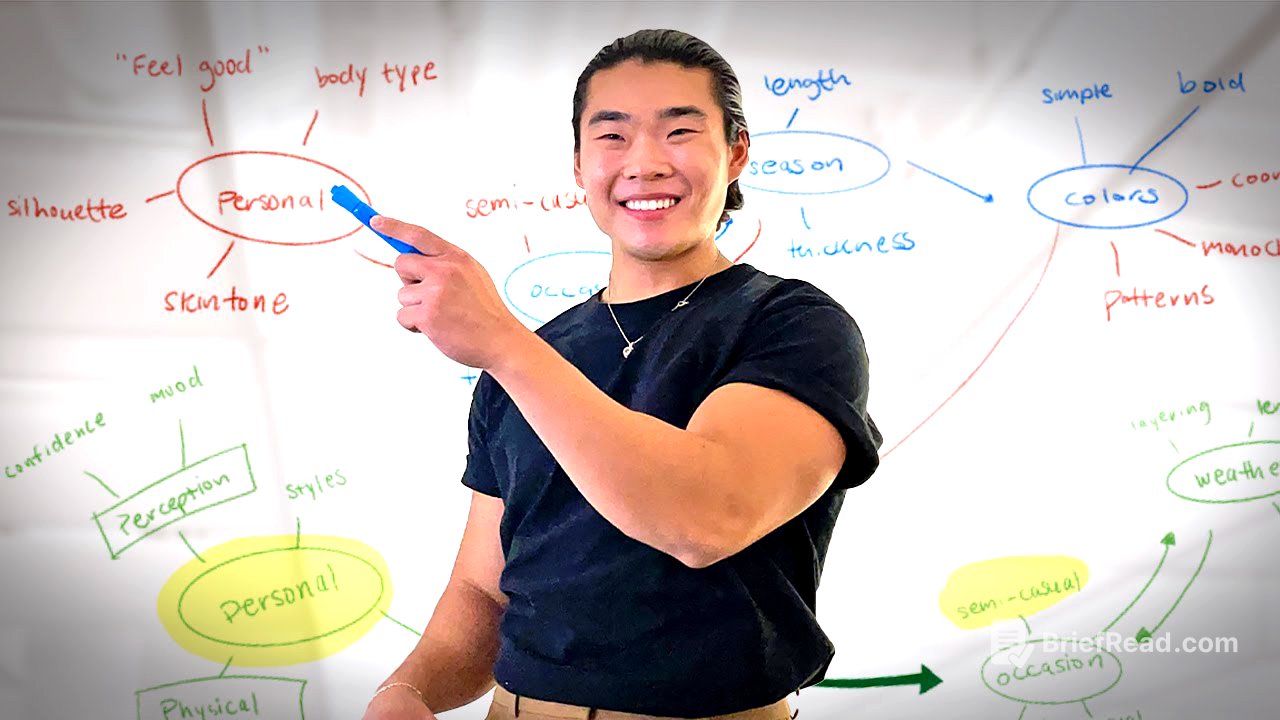TLDR;
This video presents a four-stage learning system designed to improve grades and study efficiency. The stages are priming, in-class notes, post-class immediate review, and revision. The system emphasizes understanding the big picture, actively engaging with material, and using active recall techniques.
- Priming involves understanding the big picture of a topic before class.
- In-class notes focus on annotating a pre-prepared diagram and active listening.
- Post-class review includes cleaning up notes and practicing active recall.
- Revision utilizes active recall methods like blurting, the Feynman Technique, and practice tests.
Introduction [0:00]
Jun Yuh introduces a learning system consisting of four stages: priming, in-class notes, post-class immediate review, and revision. This system aims to achieve better grades with less study time. Jun Yuh shares his background as a Dean's List biomed engineering student pursuing both a bachelor's and master's degree, highlighting his ability to balance academics with business, social life, fitness, faith, and content creation. He expresses regret that effective study methods aren't commonly taught and promises to provide guidance.
Priming: Understanding the Big Picture [1:15]
The primary goal of priming is to grasp the overall concept of a topic before attending classes. This approach enhances the brain's ability to understand and remember information by creating relevant connections. By understanding how major concepts fit together, new details presented in class become immediately relevant and meaningful. The analogy of building a Lego set is used, where studying the box front before opening it helps understand the function of each piece.
Jun Yuh uses the example of learning about fashion to illustrate the priming stage. He identifies resources like YouTube videos and notes repeated words and key concepts such as "casual," "thickness," and "layering." These concepts are then grouped based on similarities, such as categorizing "bold" and "simple" under "colors." The next step involves relating the topic to personal interests, such as picking out a good outfit. This leads to creating a visual diagram that organizes the groups in a relevant way, like starting with the occasion, then considering the season, and finally the colors.
The second part of priming involves taking a short pretest to analyze how different concepts come together to solve problems. This helps prepare for inference-based questions common in higher education. The emphasis is on attempting to apply and analyze concepts, even if the questions are initially answered incorrectly, to leverage the hypercorrection effect during class. Priming should be done every two to three weeks per topic, not per class, to broaden the scope and create general terms for upcoming material.
In-Class Notes: Active Engagement [13:30]
Priming enables active listening in class rather than being engrossed in writing down every word. Notes should facilitate learning by annotating a pre-prepared diagram. This diagram serves as a big picture reference, allowing new details to be connected to existing knowledge. In-class notes consist of three parts: annotating the diagram, noting key observations, and formulating active recall questions.
Jun Yuh shares an example of his in-class notes on fashion, showing how he added additional groups and emphasized important points on his diagram. Key observations are noted for information that doesn't immediately fit into the diagram. Active recall questions, focusing on "why" and "how," are created to facilitate later review. The goal is to spend most of the class time listening and engaging with the teacher, with only a small portion dedicated to jotting down questions.
Post Class Immediate Review: Concise Revision [21:44]
This stage involves a 30-minute review before bed, focusing on cleaning up active recall questions and refining the in-class diagram. Key observations are integrated into the framework. The primary activity is practicing active recall questions verbally to identify strengths and weaknesses. Correctly answered questions deepen understanding, while incorrect answers highlight areas for further practice in stage four.
Revision: Active Recall Applications [23:41]
Revision consists of two parts: creating an optimized diagram and applying active recall techniques. The optimized diagram, diagram number three, is a simplified and reorganized version of the previous diagrams, designed for quick and easy understanding. This involves using subgroups, illustrations, and bolding key relationships.
The second part involves active recall applications, including the blurting method, the Feynman Technique, and practice tests. The blurting method involves recalling as much information as possible from a source without looking at it, then correcting and repeating the process. The Feynman Technique requires teaching the topic in simple terms, as if to a fifth grader, to identify areas of weakness. Practice tests should be approached by freely recalling answers and explaining why other options are incorrect before consulting sources.
Conclusion [35:41]
Jun Yuh concludes by emphasizing the importance of each stage in the learning system and encourages viewers to apply it to their coursework. He mentions the importance of revision timetables, space repetition, and optimal breaks, as detailed in his guide to academic success. He expresses hope that the video has provided a starting point for viewers to craft their own learning systems and invites feedback and questions in the comments. He also teases a future project designed to facilitate this learning system.
